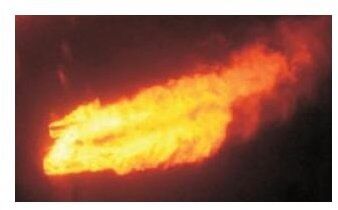The gas produced when making coke for steel making was not used for domestic applications, it was used at the steelworks as part of the steel making process.
Power station coal was pulverised not due to its poor quality but so that it could be burnt very quickly, like a giant gas burner. To generate the amount of steam required the amount of coal to be burnt was very large. The coal was not burnt in a fluidised bed (this was tried at prototype scale but never caught on), but with burners rather like giant blowtorches. Several configurations were used, generally a rectangular array of burners pointed into the boiler, but also from the corners. See example image below of two burners operating, a boiler would have 20 or more. Note the burner diameter would be about 600mm so big flames Aberthaw was designed to burn the hard coal from South Wales and used burners pointing downwards as the flame length was very long as the low volatile coal particles required a longer time in the boiler to ensure complete combustion.
The solids produced were mostly fly ash and carried over with the exhaust and collected foe the exhaust went up the chimney. This was very fine, powdery ash. Some of the material would become larger ash which would fall to the bottom of the boiler and be removed as a clinker like material.
PS When lighting power station boilers, an automatic process starts with relatively small propane burners being ignited followed by bigger fuel oil, then the coal is started one burner at a time . I once lit a boiler at Hams Hall, none of the automatic system worked so it was started with a rag on a stick dipped in a bucket of diesel and once lit poked in and the gas put on. The result was quite impressive.







